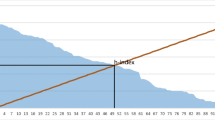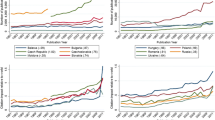Abstract
We introduce a new quantitative measure of international scholarly impact of countries by using bibliometric techniques based on publication and citation data. We present a case study to illustrate the use of our proposed measure in the subject area Energy during 1996–2009. We also present geographical maps to visualize knowledge flows among countries. Finally, using correlation analysis between publication output and international scholarly impact, we study the explanatory power of the applied measure.











Similar content being viewed by others
Notes
Elsevier’s Scopus citation database (http://www.scopus.com/) is used as data source. In Scopus, subject categories are pre-assigned to all journal articles and conference papers based on the All Science Journal Classification (ASJC). Using ASJC, we procured 358,661 publications (journal articles, reviews and conference papers) classified as Energy(all) from the Scopus database during the time period 1996–2009.
.
References
Albert, H., & Adam, J. (2003). Patent citations and international knowledge flow: the cases of Korea and Taiwan. International Journal of Industrial Organization, 21(6), 849–880.
Alok, J. (2011). China ‘leads the world’ in renewable energy. Guardian. http://www.guardian.co.uk/environment/2008/aug/01/renewableenergy.climatechange. Accessed 03 March 2011.
Bradsher, K. (2010). China leads global race to make clean energy, New York Times. http://www.nytimes.com/2010/01/31/business/energy-environment/31renew.html?_r=1. Accessed 3 March 2011.
Burrell, Q. L. (1991). The Bradford distribution and the Gini index. Scientometrics, 21, 181–194.
Burrell, Q. L. (1992). The Gini index and the Leimkuhler curve for Bibliometric processes. Information Processing and Management, 28, 19–33.
Callum, C. (2010). China’s Clean Revolution report. Global Director of Communications .http://www.theclimategroup.org/_assets/files/China-Clean-Revolution-III.pdf. Accessed 3 March 2011.
Guerrero-Bote, V., Zapico-Alonso, F., Espinosa-Calvo, M., Gómez-Crisóstomo, R., & Moya-Anegón, F. (2007). Import-export of knowledge between scientific subject categories: the iceberg hypothesis. Scientometrics, 71(3), 423–441.
Hagel, J., Brown, J., & Davison, L. (2009). Measuring the forces of long-term change: The 2009 shift index. New York: Deloitte Development LLC.
Ingwersen, P., Larsen, B., & Wormell, I. (2000). Applying diachronic citation analysis to ongoing research program evaluations. In B. Cronin & H. B. Atkins (Eds.), The Web of Knowledge (pp. 373–387). Medford: Information Today, Inc. & American Society for Information Science.
Jones, B. F., Wuchty, S., & Uzzi, B. (2008). Multi-university research teams: shifting impact, geography, and stratification in science. Science, 322, 1259–1262.
Kinver, M. (2008). “China’s ‘rapid renewables surge’”. BBC News. http://news.bbc.co.uk/2/hi/science/nature/7535839.stm. Accessed 3 March 2011.
Leydesdorff, L., Moya-Anegón, F., & Guerrero-Bote, V. (2010). Journal maps on the basis of Scopus data: a comparison with the Journal Citation Reports of the ISI. Journal of the American Society for Information Science and Technology, 61(2), 352–369.
Leydesdorff, L., & Rafols, I. (2009). A global map of science based on the ISI subject categories. Journal of the American Society for Information Science and Technology, 60(2), 348–362.
Liu, Y., & Rousseau, R. (2010). Knowledge diffusion through publications and citations: a case study using ESI-fields as unit of diffusion. Journal of the American Society for Information Science and Technology, 61(2), 340–351.
Markl, H. (2009). Challenges of Globalization for Science and Research. European Review, 17(3–4), 499–509.
Nathaniel, T., & Jonathan, E. (2006). Environmental Implications of Energy Policy in China. Environmental Politics, 15(2), 248–270.
Rowlands, I. (2002). Journal diffusion factor: a new approach to measuring research influence. Aslib Proceedings, 54(2), 77–84.
Schott, T. (1994). Collaboration in the Invention of Technology: globalization. Regions, and Centers, Social Science Research, 23(1), 23–56.
Stegmann, J., & Grohmann, G. (2001). Citation rates, knowledge export and international visibility of dermatology journals listed and not listed in the Journal Citation Reports. Scientometric, 50(3), 483–502.
Storper, M. (1999). Globalization and Knowledge Flows. In J. H. Dunning (Ed.), Globalization. Oxford: Regions and the Knowledge-based Economy, Oxford University Press.
Zhou, P., & Leydesdorff, L. (2007). A Comparison between the China Scientific and Technical Papers and Citations Database and the Science Citation Index in terms of journal hierarchies and inter-journal citation relations. Journal of the American Society for Information Science and Technology, 58(2), 223–236.
Zhou, P., Su, X., & Leydesdorff, L. (2010). A comparative study on communication structures of Chinese journals in the social sciences. Journal of the American Society for Information Science and Technology, 61(7), 1360–1376.
Zhuge, H. (2006). Discovery of knowledge flow in science. Communications of the ACM, 89(5), 101–107.
Acknowledgments
We are thankful to Prof. Henk Moed and Prof. Yuan Sun who provided their useful comments on early stage of this research.
Author information
Authors and Affiliations
Corresponding author
Appendix
Appendix
Rights and permissions
About this article
Cite this article
Hassan, SU., Haddawy, P. Measuring international knowledge flows and scholarly impact of scientific research. Scientometrics 94, 163–179 (2013). https://doi.org/10.1007/s11192-012-0786-6
Received:
Published:
Issue Date:
DOI: https://doi.org/10.1007/s11192-012-0786-6




